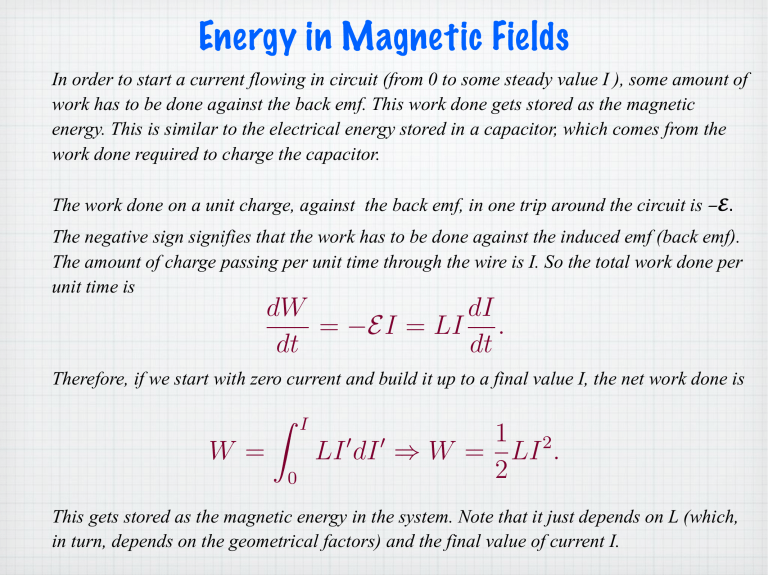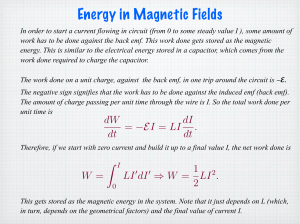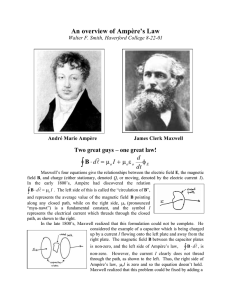
Energy in Magnetic Fields In order to start a current flowing in circuit (from 0 to some steady value I ), some amount of work has to be done against the back emf. This work done gets stored as the magnetic energy. This is similar to the electrical energy stored in a capacitor, which comes from the work done required to charge the capacitor. The work done on a unit charge, against the back emf, in one trip around the circuit is −!.# The negative sign signifies that the work has to be done against the induced emf (back emf). The amount of charge passing per unit time through the wire is I. So the total work done per unit time is dW = dt dI EI = LI . dt Therefore, if we start with zero current and build it up to a final value I, the net work done is W = Z I 0 1 2 LI dI ) W = LI . 2 0 0 This gets stored as the magnetic energy in the system. Note that it just depends on L (which, in turn, depends on the geometrical factors) and the final value of current I. Energy in Magnetic Fields There is a nicer expression for W, which is generalizable to surface and volume currents. The magnetic flux through the loop is given by = Z S B · dS = Z S (r ⇥ A) · dS = I P A · dl. The last step followed using Stokes’ theorem. The integral is over the perimeter P of the loop and S is any surface bounded by P. We also know that the flux can be written in terms of inductance and current as Therefore, = LI. I LI = A · dl. P Consequently, the energy stored can be written as 1 2 1 W = LI = I 2 2 I P A · dl. Energy in Magnetic Fields We may bring I inside the integral and write expression for W as For line current: I 1 W = 2 P A · Idl . Idl is now the current element. The above expression can be generalized to the case of surface and volume currents also. For surface current: 1 W = 2 I 1 W = 2 I For volume current: S V A · K dS. A · J d⌧. Energy in Magnetic Fields We can derive a nicer expression which involves only B. For that we eliminate J using Ampère’s circuital law, Therefore 1 W = 2 We now use the identity I r ⇥ B = µ0 J. 1 A · J d⌧ = 2µ0 V I V A · (r ⇥ B) d⌧. r · (A ⇥ B) = B · (r ⇥ A) ) A · (r ⇥ B) = B · (r ⇥ A) But ∇×A=B, hence ) A · (r ⇥ B) = B Consequently, 1 W = 2µ0 I 2 B d⌧ V 2 1 2µ0 A · (r ⇥ B) r · (A ⇥ B). r · (A ⇥ B). I V r · (A ⇥ B) d⌧. Energy in Magnetic Fields Now, 1 W = 2µ0 I 1 2µ0 2 B d⌧ V 1 )W = 2µ0 I 2 B d⌧ V I V r · (A ⇥ B) d⌧. 1 2µ0 The last step follows from Gauss’s divergence theorem. I S (A ⇥ B) · dS. Recall that we started this derivation from 1 W = 2 I V A · J d⌧. If we make the volume of integration in this equation very large (going to infinity), the integral remains unchanged, as J is zero outside V, and therefore no extra contribution comes from extra space. Therefore W given by second equation above should also remain unaltered by making V→∞. But in this limit the surface integral vanishes, as A and B both go to zero on this surface enclosing infinite volume. The only contribution comes from the volume integral. Energy in Magnetic Fields & Comparison with energy in Electric fields Therefore, we arrive at the following elegant expression for magnetic energy, in terms of B alone: 1 )W = 2µ0 I 2 B d⌧. (1) Here (∞) represents “all space”. Observe the nice parallel between energy stored in the Electric and Magnetic fields: Welec Wmag 1 = 2 Z 1 = 2 Z ✏0 (V ⇢) d⌧ = 2 (1) I E 2 d⌧. (1) 1 (A · J) d⌧ = 2µ0 (1) I 2 B d⌧. (1) Electrodynamics before Maxwell In course of our study we found the following laws describing the divergence and curl of electric and magnetic fields: ⇢ (i) r · E = ✏0 (Gauss’s law for electric field), (ii) r · B = 0 (Gauss’s law for magnetic field), (iii) r ⇥ E = @B @t (iv) r ⇥ B = µ0 J (Faraday’s law), (Ampère’s law). These equations represent the state of electromagnetic theory over a century ago, when Maxwell began his work. The exact form for these equations were not compact like the above ones, but they contained the same physical idea. It turns out that there’s a fatal inconsistency in these formulas. We have already moved to non-steady situation by considering time-dependent B. However, not all results above hold for non-steady case. Electrodynamics before Maxwell Let us examine the equation (iii). r⇥E= @B @t Take divergence on both sides. LHS gives r · (r ⇥ E) = 0. RHS gives, with the aid of equation (ii), So far so good! r· Let’s now examine equation (iv). Again, take divergence on both sides. LHS gives RHS gives ✓ @B @t ◆ = @(r · B) = 0. @t r ⇥ B = µ0 J r · (r ⇥ B) = 0. r · (µ0 J) = µ0 (r · J). Now this gives 0 only for steady state situation. In general (non-steady situation), ∇⋅J≠0. Therefore, something is amiss in the equations on the previous slide. The charging capacitor paradox! Let us apply Ampère’s circuital law in the following situation. We are in process of charging up a capacitor (non-steady situation*). In integral form Ampère’s law is given by I B · dl = µ0 Ienc = µ0 Z J · dS. Consider the Ampèrian loop as shown. The idea of finding the Ienc is to look for the total current piercing a surface that has the loop for its boundary. For the present problem, if we consider this surface as the circular one which lies in the plane of the loop, then the wire goes through this surface, giving Ienc=I. However, if we consider the surface as balloon kind of surface (which also shares the same boundary) as shown in the figure, no current passes through it, and thus we conclude Ienc=0. Therefore, we have a contradiction! This clearly demonstrates the inadequacy of Ampère’s circuital law in the above form to describe non-steady situations. [*Note that if the capacitor is fully charged, then no current is flowing in the circuit, and Ampère’s law (without Maxwell’s correction) works for any surface considered.] Fixing the Ampere’s Law Using continuity equation we have r·J= @⇢ . @t While, Gauss’s law in differential form gives ⇢ r·E= ) ⇢ = ✏0 r · E. ✏0 Substituting in the above equation, we get @(✏0 r · E) @ r·J= = ✏0 (r · E) @t ✓ @t ◆ @E )r·J=r· ✏0 . @t This gives us a clue what happens in the non-steady situation. The divergence of J in nonsteady situation gives rise to a nonzero contribution. Therefore, if we incorporate 0 ( E/ t) in the Ampère’s law, it would be just right to kill the extra divergence. @E r ⇥ B = µ0 J + µ0 ✏ 0 . @t Ampere’s Law fixed! Now let us take the divergence on both sides of @E r ⇥ B = µ0 J + µ0 ✏ 0 . @t LHS gives (“Divergence of Curl is zero”) RHS gives ✓ r · (r ⇥ B) = 0. ◆ ✓ @E @E r · µ0 J + µ0 ✏ 0 = µ0 r · J + µ0 ✏ 0 r · @t @t ✓ ◆ ✓ ◆ @E @E = µ0 ✏ 0 r · + µ0 ✏ 0 r · = 0. @t @t ◆ The last step followed from the result on the preceding slide. The equation at the top now works for non-steady cases also. For steady situation (tindependent), it reduces to ∇×B=µ0J. Ampere’s Law fixed! Ampère’s law with Maxwell’s correction, @E r ⇥ B = µ0 J + µ0 ✏ 0 , @t has a certain aesthetic appeal as well. Just as a changing magnetic field induces an electric field (FARADAY’s LAW), here we find that A changing electric field induces a magnetic field. Confirmation of Maxwell’s theory came in 1888 with Hertz’s experiments on electromagnetic waves. Maxwell called his extra term the DISPLACEMENT CURRENT: Thus @E Jd = ✏ 0 . @t @E r ⇥ B = µ0 J + µ0 ✏ 0 = µ0 (J + Jd ). @t Resolving the charging capacitor paradox! To keep calculations simple, let us assume small separation between the plates, the electric field between the plates is given by 1Q E= = . ✏0 ✏0 A @E 1 @Q I ) = = . @t ✏0 A @t ✏0 A We have @E r ⇥ B = µ0 J + µ0 ✏ 0 . @t In integral form this equation appears as I B · dl = µ0 Ienc + µ0 ✏0 Z ✓ @E @t ◆ · dS. If we now consider the flat surface (circular), Ienc=I while E=0, and therefore the line integral of B gives µ0I. ◆ Z Z ✓ If we consider the balloon surface, Ienc=0, but µ0 ✏0 Thus, the paradox is resolved! @E @t I · dS = µ0 ✏0 ✏0 A dS = µ0 I. Maxwell’s equations We now have the Maxwell’s equations (for vacuum) which are valid for all scenarios: ⇢ (i) r · E = ✏0 (Gauss’s law for electric field), (ii) r · B = 0 (Gauss’s law for magnetic field), (iii) r ⇥ E = @B @t (Faraday’s law), @E (iv) r ⇥ B = µ0 J + µ0 ✏0 @t (Ampère’s law with Maxwell correction). Together with Lorentz force law F = q(E + v ⇥ B), they summarize the entire theoretical content of classical electrodynamics. TRULY ELEGANT





